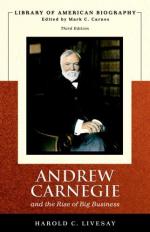
|
| Name: _________________________ | Period: ___________________ |
This test consists of 5 multiple choice questions, 5 short answer questions, and 10 short essay questions.
Multiple Choice Questions
1. Cost information enables cost-cutting per unit by __________________________ at the same output level.
(a) Increasing the speed of materials flow and increasing labor cost.
(b) Increasing the speed of materials flow and decreasing labor cost.
(c) Decreasing the speed of materials flow and increasing labor cost.
(d) Decreasing the speed of materials flow and decreasing labor cost.
2. Carnegie acquires _______ of the eight failing rail mills and follows an aggressive policy of price-cutting to anticipate its direction and expand sales.
(a) Four.
(b) Two.
(c) Five.
(d) Three.
3. From 1872 through ________, Carnegie builds an integrated industrial business to become the best-known manufacturer in the world, publishes three books, travels around the world, and becomes a philanthropist with the express intent to give away his fortune.
(a) 1909.
(b) 1899.
(c) 1889.
(d) 1879.
4. At thirty, Frick is a millionaire with _______ thousand coke ovens and three thousand acres of land.
(a) Three.
(b) Four.
(c) One.
(d) Two.
5. Carnegie organizes a partnership with business associates and colleagues that are confident of his success to do what?
(a) Find capital.
(b) Stabilize capital.
(c) Lower capital.
(d) Raise capital.
Short Answer Questions
1. By 1892, Carnegie is in ______________ and leaves labor issues to Frick.
2. Productive staff is rewarded and non-productive staff is ___________.
3. Captain Bill Jones claims success in managing labor by doing what?
4. Phipps sees possible gains in other operations and encourages Carnegie to hire who?
5. Carnegie follows the successful path of building through a depression and lack of customers by ________________.
Short Essay Questions
1. Describe the seven years of peace and prosperity in the North.
2. What happens when Carnegie goes to Scotland?
3. Why does Andrew not help Tom Scott? What are the effects of this decision?
4. What does the entrepreneurial Carnegie begin in 1872? Describe his work at this time.
5. Describe Carnegie's partners at this time.
6. What venture is formed between Tom Miller and Carnegie?
7. What are the benefits of the Cyclops and Union Mills merger?
8. Describe American steel companies between 1870 and 1900.
9. What does Phipps suggest to Carnegie? How does Carnegie benefit from this?
10. Describe Duqesne Steel.
|
This section contains 939 words (approx. 4 pages at 300 words per page) |

|




